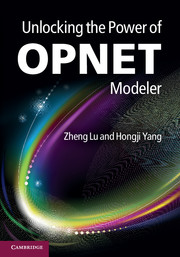Book contents
- Frontmatter
- Contents
- Preface
- List of abbreviations
- Part I Preparation for OPNET Modeling
- Part II Modeling Custom Networks and Protocols
- Part III Modeling and Modifying Standard Networks and Protocols
- Part IV OPNET Modeling Facilities
- 11 Debugging simulation
- 12 OPNET programming in C++
- 13 Traffic in OPNET simulation
- 14 External model access (EMA)
- 15 OPNET co-simulation with third-party programs
- 16 Model authoring and security
- References
- Index
14 - External model access (EMA)
from Part IV - OPNET Modeling Facilities
Published online by Cambridge University Press: 05 February 2012
- Frontmatter
- Contents
- Preface
- List of abbreviations
- Part I Preparation for OPNET Modeling
- Part II Modeling Custom Networks and Protocols
- Part III Modeling and Modifying Standard Networks and Protocols
- Part IV OPNET Modeling Facilities
- 11 Debugging simulation
- 12 OPNET programming in C++
- 13 Traffic in OPNET simulation
- 14 External model access (EMA)
- 15 OPNET co-simulation with third-party programs
- 16 Model authoring and security
- References
- Index
Summary
This chapter shows the concept of external model access (EMA; a text file representation alternative to OPNET modeler's graphic representation for modeling), the benefits of using EMA in some circumstances, and how simulation models can be constructed via EMA instead of OPNET Modeler's graphic interfaces.
What EMA is and reasons to use it
Usually, a user can access OPNET models by creating a node model or link model and reading/writing that model from OPNET modeler's graphic user interfaces (GUI) such as Node Editor, Link Editor, etc. This way can be called WYSIWYG – “WhatYou See Is What You Get.” Differing from this WYSIWYG method, EMA is a technique provided by OPNET Modeler that allows you to access OPNET models from external programs in a text format; i.e., models can be accessed via code rather than GUI. EMA code can be written in an external C/C++ program. It is different from the C/C++ code written in OPNET process model, which is via the OPNET graphic interface. Therefore, the external C/C++ program with EMA capability can interface with other programs, libraries, and databases just like a general C/C++ program. The EMA C/C++ program is compiled and linked into an executable file. By running that executable file, models and/or objects of models can be read or written or created. To write such an EMA program, you can use any text editor or C/C++ IDE (Integrated Development Environment).
Information
- Type
- Chapter
- Information
- Unlocking the Power of OPNET Modeler , pp. 207 - 214Publisher: Cambridge University PressPrint publication year: 2012
